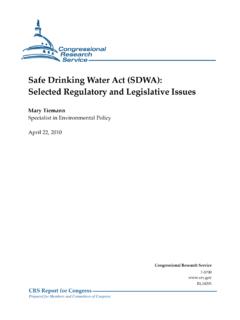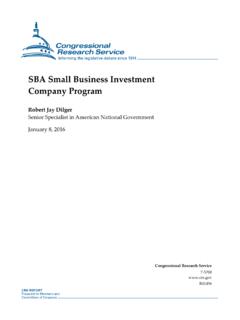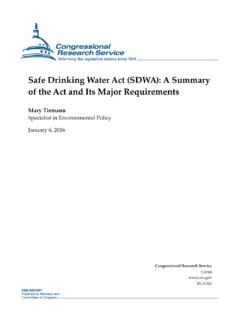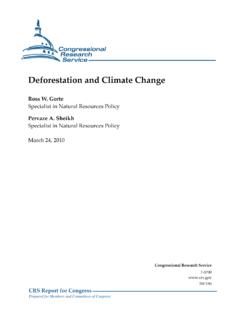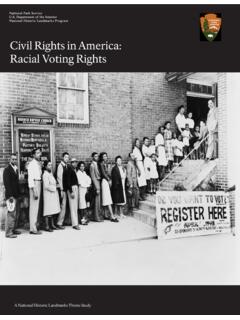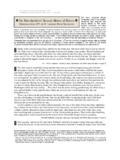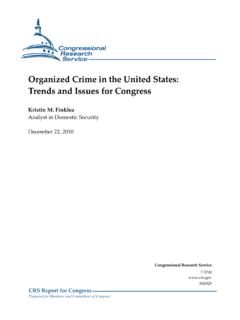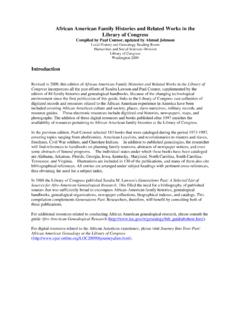Transcription of The Pigford Cases: USDA Settlement of Discrimination Suits ...
1 The Pigford Cases: USDA Settlement of Discrimination Suits by Black Farmers Tadlock Cowan Analyst in Natural Resources and Rural Development Jody Feder Legislative Attorney May 29, 2013. Congressional Research Service 7-5700. RS20430. CRS Report for Congress Prepared for Members and Committees of Congress The Pigford Cases: USDA Settlement of Discrimination Suits by Black Farmers Summary On April 14, 1999, Judge Paul L. Friedman of the District Court for the District of Columbia approved a Settlement agreement and consent decree in Pigford v.
2 Glickman, a class action Discrimination suit between the Department of Agriculture (USDA) and black farmers. The suit claimed that the agency had discriminated against black farmers on the basis of race and failed to investigate or properly respond to complaints from 1983 to 1997. The deadline for submitting a claim as a class member was September 12, 2000. Cumulative data show that as of December 31, 2011, 15,645 (69%) of the 22,721 eligible class members had final adjudications approved under the Track A process, and 104 (62%) prevailed in the Track B process for a total cost of approximately $ billion in cash relief, tax payments, and debt relief.
3 Many voiced concern over the structure of the Settlement agreement, the large number of applicants who filed late, and reported deficiencies in representation by class counsel. A provision in the 2008 farm bill ( 110-246) permitted any claimant who had submitted a late-filing request under Pigford and who had not previously obtained a determination on the merits of his or her claim to petition in federal court to obtain such a determination. A maximum of $100. million in mandatory spending was made available for payment of these claims, and the multiple claims that were subsequently filed were consolidated into a single case, In re Black Farmers Discrimination Litigation (commonly referred to as Pigford II).
4 On February 18, 2010, Attorney General Holder and Secretary of Agriculture Vilsack announced a $ billion Settlement of these Pigford II claims. However, because only $100 million was made available in the 2008 farm bill, the Pigford II Settlement was contingent upon congressional approval of an additional $ billion in funding. After a series of failed attempts to appropriate funds for the Settlement agreement, the Senate passed the Claims Resolution Act of 2010 ( 4783) to provide the $ billion appropriation by unanimous consent on November 19, 2010.
5 The Senate bill was then passed by the House on November 30 and signed by the President on December 8 ( 111-291). Like the original Pigford case, the Pigford II Settlement provides both a fast-track Settlement process (Track A) and higher payments to potential claimants who go through a more rigorous review and documentation process (Track B). A moratorium on foreclosures of most claimants'. farms will remain in place until after claimants have gone through the claims process. On October 27, 2011, the District Court for the District of Columbia granted final approval of the Settlement agreement.
6 Under the terms of the court order, claims could be submitted beginning on November 14, 2011, with a deadline for filing claims of May 11, 2012. Approximately 89,000. claim forms were mailed out. Nearly 40,000 of them ultimately were filed. Of those, approximately 34,000 were deemed complete and timely. A determination of the validity of the claims is expected to be completed in June/July 2013, after which the claims administrator will begin distributing payments to successful claimants. Preliminary estimates from the claims administrator suggest that 17,000-19,000 claims will be positively adjudicated under Pigford II, a lower proportion of successful claims than under Pigford I.
7 This report highlights some of the events that led up to the original Pigford class action suit and the subsequent Pigford II Settlement . The report also outlines the structure of both the original consent decree in Pigford and the Settlement agreement in Pigford II. In addition, the report discusses the number of claims reviewed, denied, and awarded under Pigford , as well as some of the issues raised by various parties under both lawsuits. It will be updated periodically. Congressional Research Service The Pigford Cases: USDA Settlement of Discrimination Suits by Black Farmers Contents 1.
8 1. USDA-Commissioned Study .. 2. The Original Pigford Settlement .. 2. Class Action Suit .. 2. Terms of the Consent 3. Current Status .. 5. Cumulative Data .. 6. In re Black Farmers Discrimination Litigation ( Pigford II) .. 7. The Settlement Agreement and Claims Review Process .. 8. Census Enumeration of Black Farmers .. 9. Legislative 10. Tables Table 1. Track A Statistics as of February 16, 2012 (Final) .. 6. Contacts Author Contact 11. Congressional Research Service The Pigford Cases: USDA Settlement of Discrimination Suits by Black Farmers Introduction In 1999, a federal district court judge approved a Settlement agreement and consent decree in Pigford v.
9 Glickman,1 a class action Discrimination suit between the Department of Agriculture (USDA) and black farmers. Due to concerns about the large number of applicants who did not obtain a determination on the merits of their claims under the original Pigford Settlement , Congress enacted legislation in 2008 that permitted any claimant who had submitted a late-filing request under Pigford and who had not previously obtained a determination on the merits of his or her claim to petition in federal court to obtain such a determination. The multiple claims that were subsequently filed were consolidated into a single case, In re Black Demographics Farmers Discrimination Litigation The 2007 Census of Agriculture reported that (commonly referred to as Pigford II),2 and an million farms operated in the United States.
10 Of this total, agreement was reached to settle these claims. 32,938, or approximately of all farms, were This report discusses both the original Pigford operated by african Americans. consent decree and the subsequent Pigford II Over 74% (24,466) of african American farmers in the Settlement . Before turning to the main United States reside in Texas, Mississippi, North and discussion regarding the litigation in these South Carolina, Alabama, Georgia, Virginia and Louisiana. cases, it is useful to understand the historical Average annual market value for farms operated by background leading up to the litigation, as african American farmers in 2007 was $30,829.


